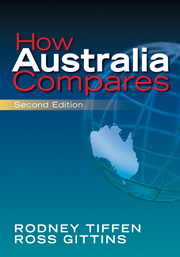Book contents
- Frontmatter
- Contents
- List of tables and figures
- Preface to the second edition
- Acknowledgements
- Reading the tables
- Abbreviations
- Introduction
- 1 People
- 2 Government and politics
- 3 Economics
- 4 Work and labour
- 5 Government taxes and spending
- 6 Health
- 7 Education
- 8 Inequality and social welfare
- 9 International relations
- 10 Environment
- 11 Science and technology
- 12 Telecommunications and computing
- 13 Media
- 14 Family
- 15 Lifestyles and consumption
- 16 Crime and social problems
- 17 The search for scoreboards
- 18 The Howard impact
- Sources and references
15 - Lifestyles and consumption
Published online by Cambridge University Press: 05 June 2012
- Frontmatter
- Contents
- List of tables and figures
- Preface to the second edition
- Acknowledgements
- Reading the tables
- Abbreviations
- Introduction
- 1 People
- 2 Government and politics
- 3 Economics
- 4 Work and labour
- 5 Government taxes and spending
- 6 Health
- 7 Education
- 8 Inequality and social welfare
- 9 International relations
- 10 Environment
- 11 Science and technology
- 12 Telecommunications and computing
- 13 Media
- 14 Family
- 15 Lifestyles and consumption
- 16 Crime and social problems
- 17 The search for scoreboards
- 18 The Howard impact
- Sources and references
Summary
Housing
Home ownership has long been a key aspiration of people in Australia and many of the other selected countries. It offers financial security from instabilities in the rent market, but also a personal security and satisfaction about fashioning people's own place of residence. It is also the central financial investment that many families make.
Home ownership is much easier where land is relatively cheap, so as Table 15.1 shows it was traditionally high among the four New World countries. As early as 1911, half of Australians owned their home, a figure that was reached in Britain only in the 1970s. Home ownership also tends to be higher in rural areas than in major cities. In 1960, Japan topped the table and its declining rate over the next 15 years reflects its rapidly increasing urbanisation. Many families owned their small village homes, but their children could not afford to buy real estate in Tokyo.
The countries show considerable divergence and contrasting trajectories. The 2000 home ownership rate is substantially (seven percentage points or more) higher than in 1975 in 10 countries, all European. Many of these started from a comparatively low base. Despite the rising prosperity of the other countries, housing ownership rates have plateaued. In particular, Australia, the United States and Canada (who in the post-World War II decades were in the vanguard) are now just above the mean.
In all countries, then, a substantial proportion of the population lives in rental accommodation. Younger people who may eventually go on to own their home form a large part of this group, but many people, especially from poorer socio-economic groups, will always rent.
- Type
- Chapter
- Information
- How Australia Compares , pp. 204 - 213Publisher: Cambridge University PressPrint publication year: 2009



